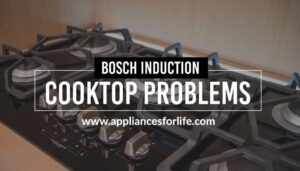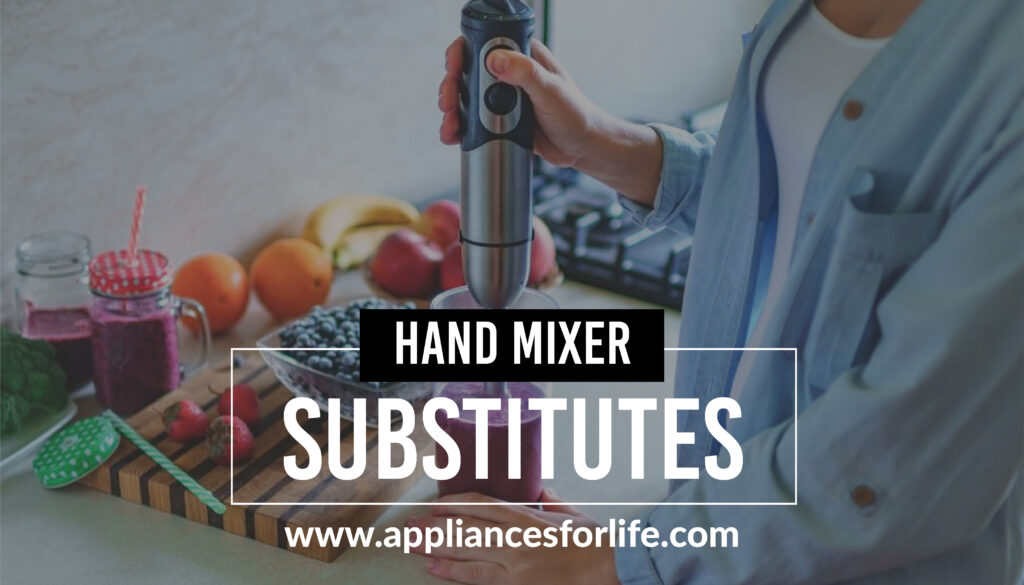- Bottom line is, hand mixers are great, they can literaly enable you enjoy your food making process. Hence, we are not having a discourse on what to use instead of a hand mixer because they are useless-we are rather discussion this because you may find yourself in a situation where an alternative is necessary or where you’ll need to improvise.
- There are a number of hand mixer substitutes out there and all you need to do is pick the one that suits your mission. A food processor is a worthy replacement, just like a stand mixer if what you need is a fine whipp on your recipes. If however it is the issue of affordability for you, there are a number of manual substitutes you can also use for your mixing- A spatula or a whisk will do very well. It may not just be as efficient as an automated device designated for that purpose. Find out more in this article
While a hand mixer can conveniently deliver great results mixing some kitchen recipes, there are other kitchen appliances that will beat your recipes and mix your cake batters without any hassles. Hence, you necessarily do not have to restrict yourself to a particular device, especially if you want your recipes beaten and mixed differently. Like other Kitchen appliances used for mixing and whipping, a food processor can be an indispensable tool in the kitchen, especially if you are dealing with grating, pureeing, or slicing.
Table of Contents
ToggleFood Processors as a substitute for Hand Mixers
Food Processors are a perfect substitute for hand mixers and even blenders because, just like hand mixers, they puree effectively. An immersion blender also purees perfectly- Find out the differences between an immersion blender and a hand mixer. They are particularly great for making mashed potatoes and other recipes that require pureeing. Despite the similar functions of both kitchen appliances, it is important to know that a food processor has a wider variety of uses. And this is why a food processor is a preferred choice for most users. However, if all you use your hand mixer for is mixing cake batter, you may just need to stick to it. because simple mixing, it works better than a food processor.
If, indeed, a Food Processor will serve as a perfect alternative to your hand mixer, you must use it appropriately. The best way to get the desired result is to optimize its functions accordingly. The section below discusses easy steps to using a Food Processor.
How to Use a Food Processor
Step 1: Plug it in and attach the jug to the base
Someone might say that the instruction to plug the device into a power source is unnecessary rhetoric and, as such, needless to say. Well, such a fellow will have a point, but it is good to understand also that this is legitimately the first step to getting a food processor going. Fully unwind the capable and carefully plug it into the mains
That must have been easy. If you have done that, you may proceed to attach the food processor jug to its base. You need to do this properly or the mixer may not work. With most food processor models, a twist anti-clockwise makes it lock into place perfectly fine. If you’re using the large main base, that’s all, there is to it. If you’re using a smaller subsidiary bowl, this is the point when you can slot that in on top of the main stand.
Step 2: Choose your blade/attachment
The mixing and pureeing mechanism of a food processor are its blades. You can attach it by clicking it over the central mechanism. Although it can take a little wiggling to get it locked in. It is advised that you choose your blades or attachments carefully here because the attachment that you choose determines the result that you get in the long run. If what you are looking to do is a mix, mince, mash, puree, or chop with your food processor, then you should go for the main blade.
Step 3: Fix the lid properly
Once you have fixed your attachment appropriately, carefully place the lid, and remember, If you’re planning to use the main blade, you’ll need to add your ingredients before clipping the lid onto the top of the mixer’s bowl.
Step 4: Turn it on
Start the motor with the movement of the blades or discs by pressing the power button on your model. If you need to use a pulse function, rather than have the motor running continuously, use the pulse button if your model has one. If not, you can try pressing the on-and-off button repeatedly until you achieve the desired texture for what you’re making.
Step 5: Add your ingredients
Now is the time to process your food. If your attachment is a slicing disc, bear in mind that some larger items may need to be cut down into smaller bits to fit through the tunnel that connects to the disc. Once the machine is on, and the motor starts running, push the ingredients through the funnel, towards the slicing disc, using the funnel cover. This method can also be utilized to keep some pressure on the ingredients. Take caution as you do this to avoid your finger slipping through the tunnel into the disc. When this is done, and properly so, your ingredients should be pureed and mixed to perfect taste
Step 6: Clean the elements
Now, it is time for maintenance. Once you are done processing your recipes, clean them up to put them in good condition for subsequent use. The key to keeping your food processor in good condition is ensuring you wash everything straight away. Carefully remove any blades or attachments and wash with warm soapy water. If you discover that some leftover ingredients are stuck on the bowl or the blades, you may either soak it out for a while or scrape it off. After washing, you should leave it to air dry for a moment, and be good for your next use.
Stand Mixers as a Substitute for a Hand Mixer
Stand Mixers are famous for their versatility. They can be used for a wide variety of baking and cooking, even those that go way beyond mixing cookie dough and cake batters. Because of its versatility, a stand mixer can easily become the center of any kitchen, replacing hand mixers in their functions. Although some argue that a hand mixer can be conveniently manipulated and swirled around to reach every corner of one’s recipe bowl, a stand mixer will conveniently do the same, certainly with a different method, but the outcome is guaranteed to be just as desirable.
It is important to note that the mastery of usage will go a long way to achieving the desirable result when one uses a stand mixer. Hence, the technical but easy-to-grab method of using a stand mixer is explained below.
How To Use A Stand Mixer
Step1: Place Your Stand Mixer On A Flat Surface
This tip may seem unnecessary, but it is just pertinent that we emphasize the need to always find a leveled ground for a stand mixer. This is worthy of note simply because a leveled ground/platform will not only help your ingredients blend more consistently, but also it will significantly reduce the risk of damage to your stand mixer. A stand may be kept on a cupboard or a shelf when not in use and even when the need arises.
Step 2: Select and Attach the right Accessory
The need to select the right accessory for your mixing or whipping, as the case may be, can not be emphasized enough. Instrumental to achieving the desired outcome from using your stand mixer is selecting the appropriate or fitting accessory to achieve your aim. You probably already have this figured out, but the first step to picking the right accessory is asking yourself what outcome you are trying to achieve. You need to know whether what you want is to stir, mix, beat, or knead-to mention a few.
There is a range of accessories to choose from. You can go with a flat beater which is the main accessory for most mixing, stirring, and blending jobs. To put it simply, a beater is the best fit for a batter. Whether what you’re trying to achieve is a cake, doughnuts, or waffles, a flat beater is your guy. If you use a stand mixer for mashed potatoes, a flat beater is your best bet.
Now, if we are talking of immense power, the whip is our confidant anytime. Invite a whip to the occasion, and it will give your recipes the perfect whip. Not only is this whip powerful, it is also quick. It is even quicker than the beater. This is a good feature because it incorporates air into your ingredients for recipes requiring aeration. Use the whip for making whipped cream or whisking eggs for omelets, souffle, or meringue.
If what YOU are making is a dough-like pizza dough, pasta, or pretzels, the Dough Hook is your ally. It solves all your dough problems and leaves you an achiever.
Once you’ve selected the proper accessory, it’s easy to attach it to your stand mixer. Each accessory installs under the head of your stand mixer, whether you have a tilt-head or bowl-lift model. To attach an accessory to a tilt-head stand mixer, slide the lever to unlock the head and tilt it backward. For bowl-lift models, you’ll reach up underneath.
Step 3: Secure your Mixing bowl
It is also important to secure your mixing bowl perfectly. How you secure a mixing bowl depends on the kind of mixer that you have- whether it is a bowl-lift or a tilt-head stand mixer and you should know that the technique does not vary whether you have a glass, stainless steel, or a ceramic bowl.
To attach a mixing bowl to a tilt-head stand mixer, align the bowl with the bowl-clamping plate. Thereafter, push downward just slightly and twist clockwise from the top until it is perfectly secure. To confirm that the bowl is perfectly secured, gently pull it upward or attempt to wiggle it slightly. If it is perfectly secured, the bowl should not move out of its position at all.
On the other hand, to attach Bowl-Lift Stand Mixers, turn the speed control to OFF and unplug your stand mixer. Put the bowl-lift handle in the DOWN position and position the bowl supports over the locating pins. Press down on the back of the bowl until you hear the pin snap into the spring latch. You should get an audible “snap” if done correctly.
Step 4: Add your Ingredients
After properly positioning your stand mixer, you can add your initial ingredients. While doing this, pay attention to the order in which you add your ingredients. This tip is critical to achieving the best outcome if you are dealing with multiple recipes. You may need to add certain ingredients after the mixing process may have started. Take note of this to get the best results.
Step 5: Turn the Mixer on and select the correct speed
In most cases, a cursory look is not even necessary to find your power button. It is usually conspicuous except the manufacturer expects you to ‘work for it.’ Locate the power button and turn it on. Thereafter, select the right speed by lowering the head of your tilt-head stand mixer. If that is the case, slide the locking lever to the locked position or raise the bowl of your bowl-lift mixer to the up position, using its lever. Slide your stand mixer’s speed lever to the first position, which “turns it on.” Slowly adjust the speed lever until you reach the correct speed for your task, depending on your recipe. Note that this method works best for KitchenAid stand Mixers.
After selecting the right speed, monitor your mixer as it turns. This is how you know when you are over-mixing or over-whipping your recipes or not. With the powerful motor of a stand mixer, your whipped cream can turn to butter in seconds, and overmixing your cake batter will make it dense and flat from too many gluten strands.
Step 6: Detach your accessories and Clean your stand mixer.
This is pretty straightforward. Carefully detach your accessories and wipe them clean when you are done. Make sure to wipe the body of the stand mixer also with a damp towel to avoid your recipe getting stuck to it
Whisks as a Mixer Substitute
Sincerely, a manual whisk can never be a match for an automated mixer for obvious reasons. To use a whisk effectively, you may need to put your wrist through a lot stress-the kind of stress that you may not necessarily encounter when you are using an automated hand mixer. Hence, we cannot strictly say that this mixing tool is a perfect substitute for a hand mixer. However, as one of the tools that can be used for effective mixing, especially when a user is not predisposed to an automated hand mixer, it is also important to give this tool a chance.
You will find whisks in many shapes and forms. There is mini whisks ideal for quickly mixing spices into hot drinks, and you will find others, too, perfect for whisking cake batter. A whisk can replace a hand mixer; the secret is in how to use them. A small whisk works well for little jobs, such as combining ground spices for a dry meat rub or whipping medicines or tinctures into hot or cold beverages. Larger whisks can handle thicker doughs and batters.
How to Use a Whisk
The whisk will do a lot of the hard work, but you can wear out your wrist if you are working the kitchen tool incorrectly.
The best way to use a whisk as a hand mixer substitute with your ingredients is to swoop down to the bottom of the full bowl and lift upward. This looping method will incorporate all of the ingredients together. Hold the bowl as you whisk to ensure that the ingredients don’t find their way all over the kitchen.
When working with wet ingredients, such as beating eggs into cream, start slowly and build up to a faster speed. Don’t use the whisk for too long with eggs, or you may overbeat the whites.
FAQs
What Can I Use Instead Of A Hand Mixer to make a cake batter?
A perfectly whipped cake batter is necessary if one must achieve a stunning end result for a cake. The bestool for this purpose would be an automated device for mixing but if you do not have access to thatyou can still whip your batter with a whisk. To do this, make sure you whip your eggs for three minutes instead of just thirty seconds that a hand mixer requires.
What Is A Bowl Lift Design In A Stand Mixer?
A bowl lift design is one where the stand mixer has its head fixed. The bowl can be adjusted by cranking the two clamps on either side of the stand. When you want to remove the attachment of the mixer, you lower the bowl and when you want to mix the ingredients in the mixing bowl, you crank it up.
18 MINUTES
ESTIMATED TIME DESIGNING AND UPLOADING THIS ARTICLE
9 HOURS 44 MINUTES
ESTIMATED TIME RESEARCHING AND WRITING THIS ARTICLE
You Might Also Like

4 best open box counter depth refrigerators
Using the word seamless is apt to describe an aesthetically perfect kitchen design. However, achieving a perfect aesthetic design is almost impossible without a properly set-up kitchen space. A seamless kitchen looks like it was made just right and just for you, but this perfection

The Best Rheem Professional Classic Rtex Electric Tankless Water Heaters
If you’ve been looking for high-quality tankless water heaters, you may have encountered Rheem. Rheem is a household name with decades of experience in water heating, and this article explores some of the best Rheem professional classic Rtex electric tankless water heaters. A standard Rheem

Water Inlet Hose for Portable Washing Machines
Installing your washer may seem easy until you get into the thick of the action. One of the things you need to make the installation process of your portable washing machine successful is a quality portable washing machine hose. In this article, we’ll be discussing

State of the Art Electric Stoves For Sale
Electric stoves today offer the consumer the chance to cook on a sleek and stylish stove at an affordable price while still being kind to the environment. They are safe and simply the best type of stove to use. If you are upgrading your kitchen

The Best Force 10 Electric Stove Reviews For That Rugged Marine Environment
We invite you, dear reader, to take a dive with us today and delve into Force 10 electric stove reviews. The menu of Force 10 appliances is varied, offering electric cooking appliances, from Ceramic Glass Cooktops to full-size Galley Ranges. Other features that stand out

Best 3 Dishwasher For A Rental Property
It is trite that one of the best investments in recent times is real estate investments and this is partly because rental properties keep appreciating in value. It is almost a constant factor that your rent today will increase by some percentage after a certain

Bosch Induction Cooktop Problems and Solutions
Induction cooktops are great, but even they also have their own problems one has to deal with occasionally, depending on the depth. We’ll be taking you through the different problems you are likely to encounter when you’re using a Bosch induction cooktop. Bosch is regarded

Top Appliance Repair Companies
It’s okay for your appliances to need repairs at some point, after all, they’re not built to last forever. However, when this happens, it’s very important you have the right knowledge on how to repair them or you know the best appliance repair companies. This

How to Clean a Maytag Washing Machine?
Maytag washers have been designed to stand the test of time. They have a sterling reputation for durability among other washing machine brands in the United States. However, just like every other machine, a Maytag washer too can experience necessary wear and tear and if

GE Washing Machine Troubleshooting
Running a washing machine is not as hard as many people think, especially when you have the right one in your laundry room. However, it also comes with its downsides, one of which is how to troubleshoot it when problems arise. We’ll be using our

